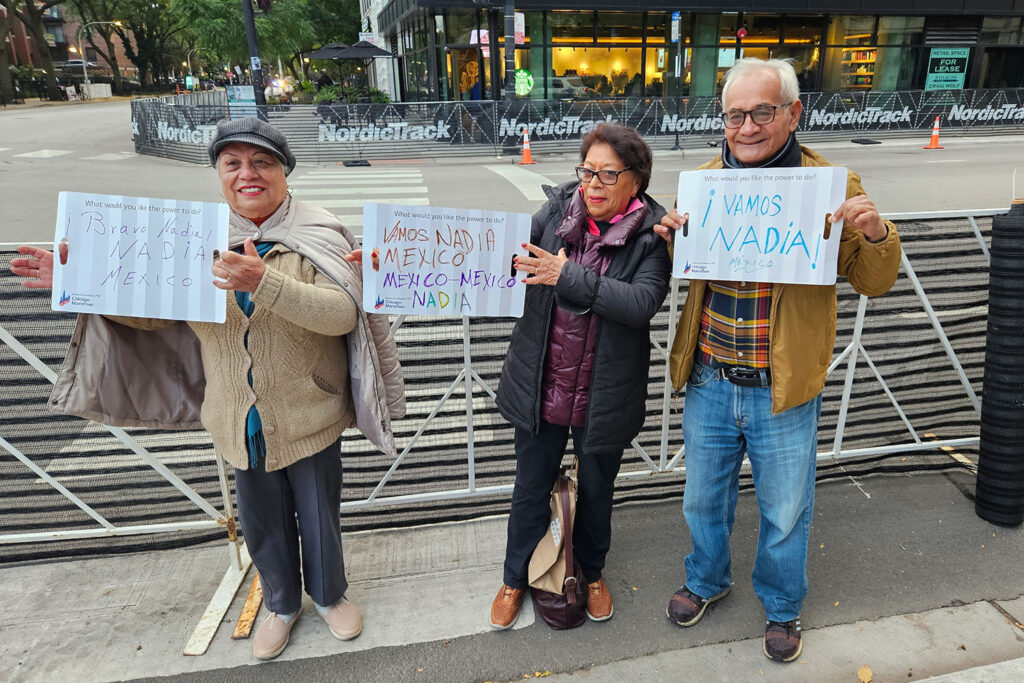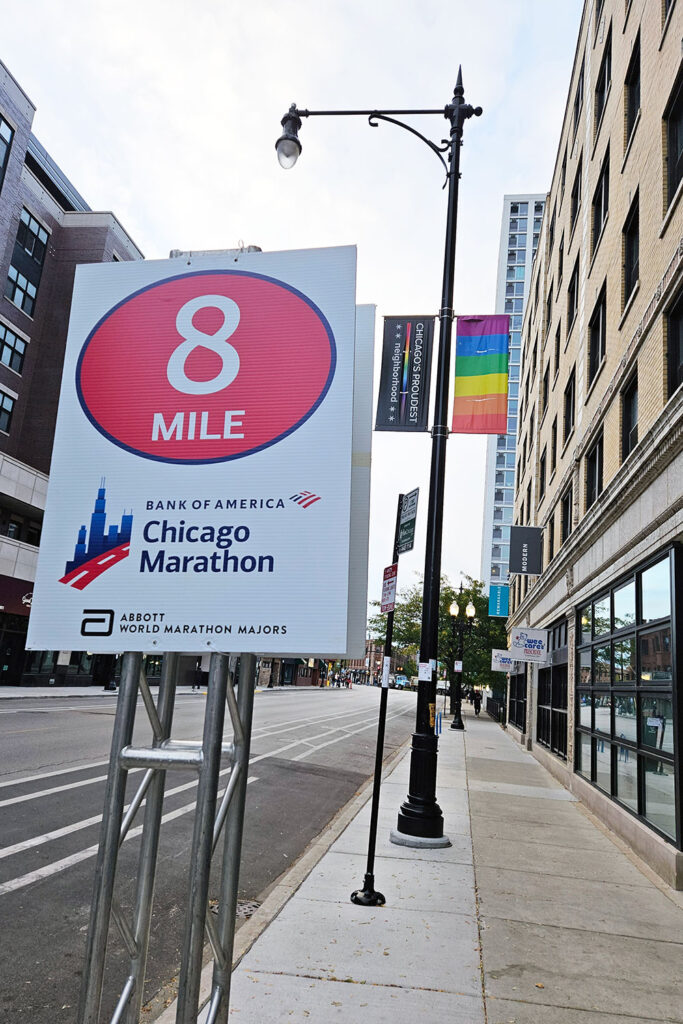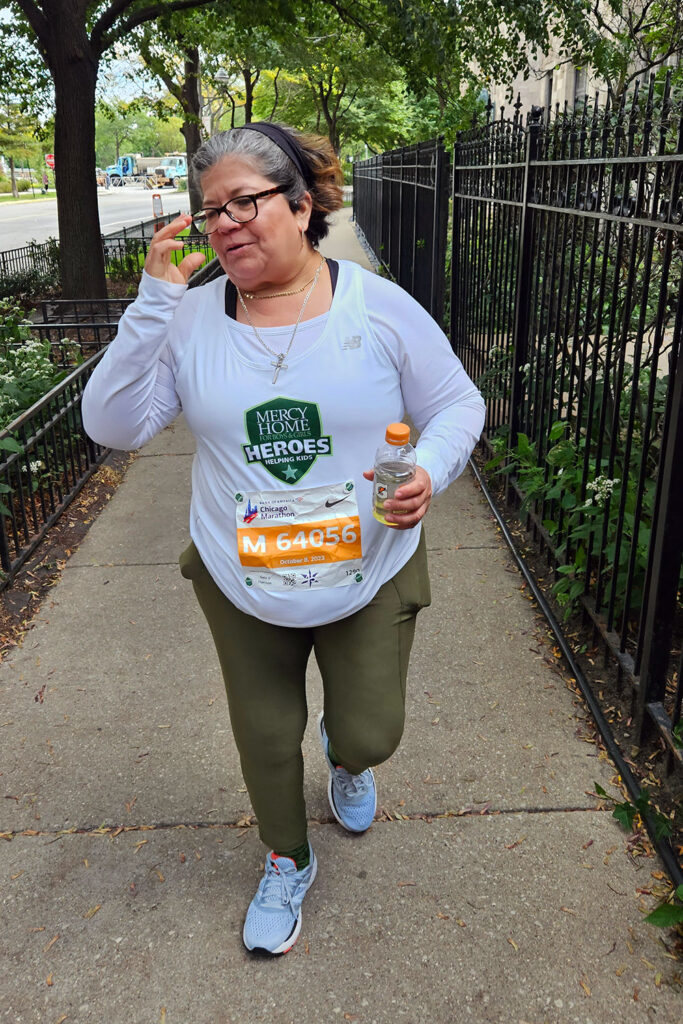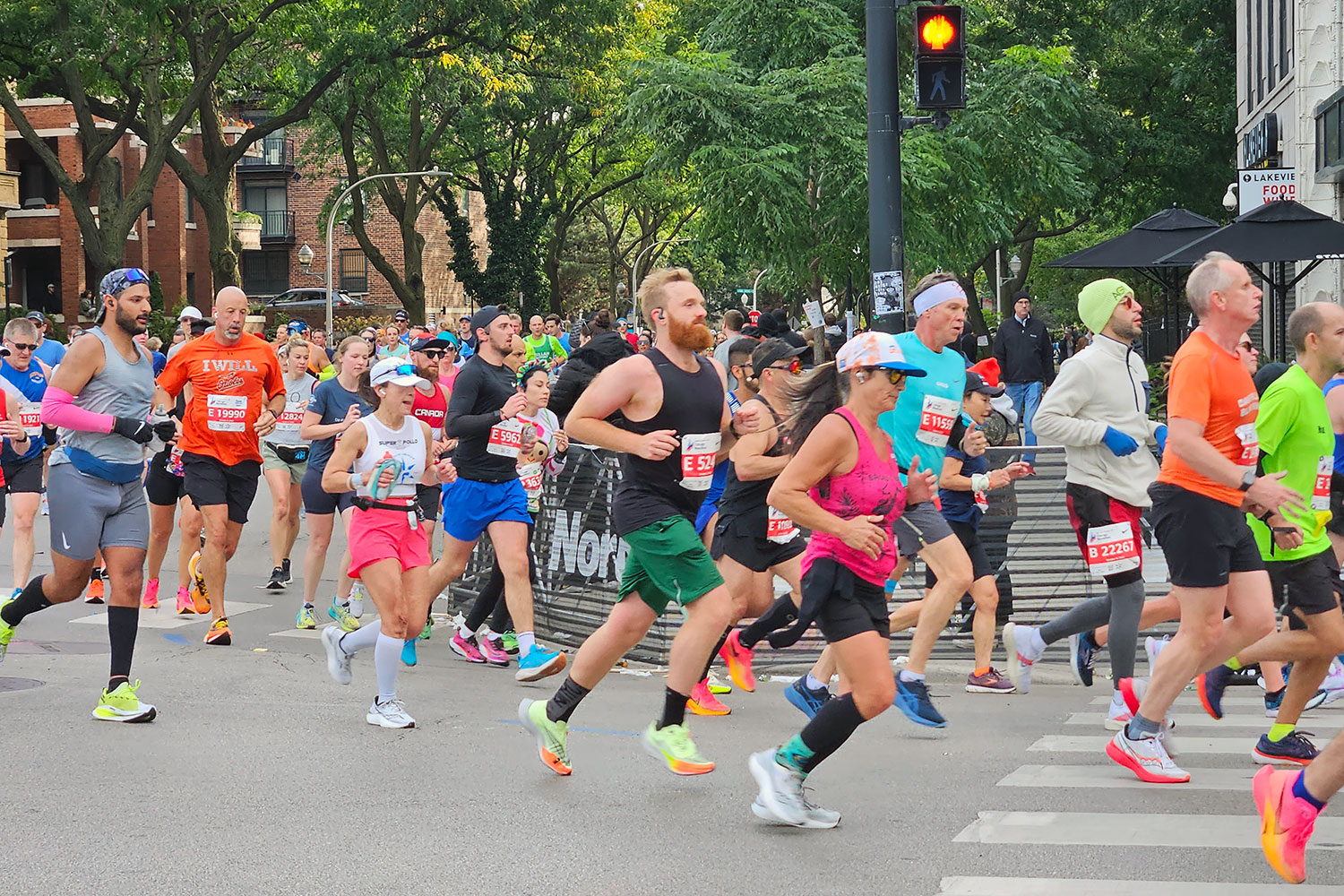This year’s Chicago Marathon was historic for two reasons: a record number of entrants, and a world record time. Here at Chicago magazine, we watched the marathon at the 8-mile mark, near the corner of Broadway and Sheridan, in Lake View. It was a good vantage point. At eight miles, runners are fresh and full of hope for a personal record time — unlike at the 21-mile mark, in Chinatown, where runners are bonking, puking, walking hunched over, and stopping to stretch concrete calves. Here are some observations from a marathon morning of marathon watching.
7:10 a.m.: Streets and San trucks idle at the corner of Broadway and Sheridan, blocking traffic. Estela Munoz stands behind the metal barrier, holding a hand-lettered sign: “VAMOS NADIA. MEXICO MEXICO.” Munoz’s daughter, Nadia, has traveled all the way from Mexico City to run this marathon.
“Her best time is 3:20,” Estela says. “She finished 100th in the Tokyo Marathon.”
(Nadia will finish 9,382nd in the Chicago Marathon, with a time of 3:26.)

7:32 a.m.: Down in Grant Park, the gun goes off.
“They’re on their way!,” shouts a radio announcer. “Will it be Ruth Chepngetich against the clock, or will Sifan Hassan track her down?”
More sports cliches: “The table is set for these guys. This is the time to make it happen. Beautiful day for racing: 46 degrees. It checks all the boxes.”
7:46 a.m.: The first police motorcycle appears, presaging the arrival of the leading wheelchair racer, Marcel Hug of Switzerland. The clock car reads 25:00. Hug is rolling along at three minutes a mile. He’s far ahead of the second- and third-place chairs. From a distance, the hunched-over wheelchair racers look like crabs.
7:55 a.m.: Signs: SMILE, YOU GOT THIS. YOU ARE ENOUGH. YOUR BUTT LOOKS GREAT. RUN LIKE SULLY IS ON YOUR TAIL.
“That’s my brother, Matt Sullivan,” says the holder, Mikaela Sullivan. “I’m throwing him under the bus. He doesn’t run marathons anymore, but I’m rooting for the guys who stuck around.”
8:07 a.m.: Police motorcycle rounds the corner, followed by a clock car. Here come the leaders! The lead pack is small for the 8-mile mark, consisting of three Kenyans: Kelvin Kiptum, Daniel Mateiko, and an anonymous pacesetter. They’re running so powerfully their every stride looks like a surge. Kiptum will win, but this 4:40-a-mile pace will break Mateiko, who will not finish.
8:12 a.m.: The first woman, Ruth Chepngetich of Kenya, appears, running alongside a male pacesetter.
8:17 a.m.: The field is thickening, climbing from the base of the bell curve: there are no more gaps between runners. The race is becoming a flow. The competitors are starting to look like civilians, in t-shirts, long sleeves, and baseball caps.
8:28 a.m.: Sign: “I SURVIVED MY HUSBAND’S MARATHON TRAINING.”
8:32 a.m.: Two runners holding 3:05 pace group signs. These runners don’t look as smooth as the elites — they hold their arms high, their bodies are thicker than those of the spindly Kenyans — but they’ll kick your ass at your local running club.
8:40 a.m.: Romy Lawrence is holding a South African flag and a sign labeled “Kelsey.”

“She’s about to get here,” Lawrence says.
“How do you know?” I ask.
Lawrence shows me her phone: “You just put the bib number in and you can track them.”
8:46 a.m.: This morning in law enforcement, a cop is watching the race from inside an SUV, and two U.S. Marshals in full body armor are walking up Broadway.
8:50 a.m.: Man holding a cardboard cutout: a red circle pasted on a green oval. “That’s an olive,” he explains. “I’ve got a couple runners, and one of them’s Olivia. Not the martini style, just an inside joke.”
8:56 a.m.: The 3:35 pace group passes by. Compared to the runners ahead of them, they all look like joggers, with short, shuffling strides. Still, they’re all running faster than my best marathon: 3:52 in Rockford.
9:05 a.m.: Sign: BECAUSE 26.3 WOULD BE CRAZY.
9:07 a.m.: Radio announcer: “One record has been smashed today: 48,944 runners started the Chicago Marathon. We’re going to see the millionth finisher at the Chicago Marathon cross the line today.” (The millionth finisher will receive a case of Goose Island beer.)
9:24 a.m.: The runners are looking less serious: There’s a man wearing a Pittsburgh Penguins jersey, another with two Mexican flags flying from a baseball cap, and the first shirtless man.
9:33 a.m.: The race is over, at least for one man: Kelvin Kiptum finishes in 2:00:35, breaking fellow Kenyan Eliud Kipchoge’s world record by more than 30 seconds. Because the runners set off in waves, not even half the field has passed the corner of Broadway and Sheridan yet.
9:38 a.m.: A runner dressed as a hot dog, followed closely by a runner dressed as the cartoon character Mario.
9:43 a.m.: A man stops to kiss his mother.
9:45 a.m.: A man stops to kiss his wife/girlfriend.
9:50 a.m.: In the United States, marathoning is a participatory sport, not a spectator sport. Most people are here to see friends and family run, and have no interest in the feats of the elites.
“We’re here for Mike, who is running for Misericordia, and Luke, who is running for the vets,” says Ed O’Brien.
“Did you know the winner set a world record?” I ask Ed.
“Where is he from? Did they say?”
“Where do you think?”
“Kenya.”
“Right.”
“I didn’t want to be stereotypical.”
9:53 a.m.: The first runner stops to walk.
9:55 a.m.: Runner’s t-shirt reads “Broken knee in February.” He’s wearing a brace on his left knee.
10:01 a.m.: The 4:20 pace group passes by, running at less than half the speed of Kelvin Kiptum. Since the average man finishes the race in 4:13 and the average woman in 4:39, this is the midpoint of the pack.
10:15 a.m.: Sign: YOU’RE RUNNING BETTER THAN OUR GOVERNMENT.
10:29 a.m.: The field has thinned out enough for me to run across the street and use the bathroom at Starbucks.
10:33 a.m.: Gray hair, gray beards, round bodies. No one looks like a natural runner. Everyone is shuffling.
10:42 a.m.: The 5:45 pace group passes by. All its members are walking.
10:51 a.m.: Man in Blackhawks jersey, juggling hockey sticks.
10:53 a.m.: Little boy runs alongside marathoners until his mother grabs him and pulls him back to the curb.
10:55 a.m.: Police SUVs with flashing blue lights appear, with this message from a bullhorn: “Runners not maintaining the pace with the official pace car please be prepared to move to the sidewalk.” By now, everyone is walking.

11:25 a.m.: Gabriela Lucio is the last-place contestant in the Chicago Marathon. This is her seventh. Her best time is 7:14.
“It used to be eight hours, running and walking,” she says. “One year, I did 10 hours. The medals was gone. I was almost crying because I didn’t get my medal. I was at the finish line, but the finish line was gone.”
Lucio, who raised $1,500 for Mercy Home for Boys and Girls, has finished last before.
“Sometimes, I am around with people, but sometimes nobody else. I don’t like to quit.”
By the time Lucio reaches Broadway and Sheridan, the 8-mile marker has been pulled down from its lamppost, and the street sweepers are scouring discarded cups from the pavement. All the spectators are gone, but 57-year-old Lucio plugs along, pushing her stout body forward on the sidewalk. She passes eight miles in 2:49. That’s a 21:07 per mile pace, which will bring her home in nine hours and nine minutes.
Her advice to other slow marathoners? “Keep going, never quit, and maybe next year will be better.”



